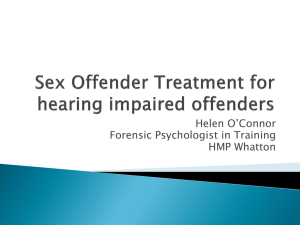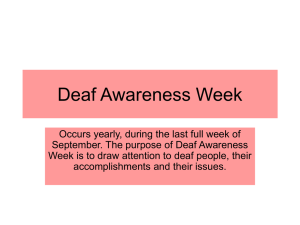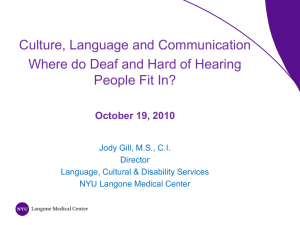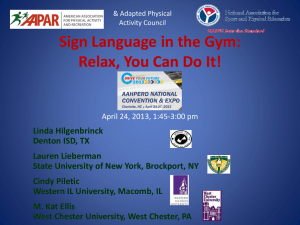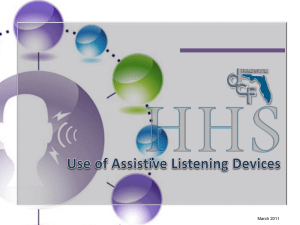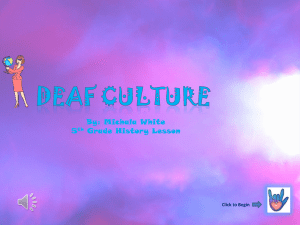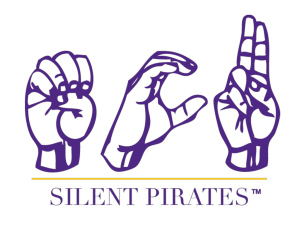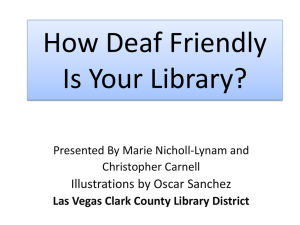midterm_project-_reading_instruction
advertisement
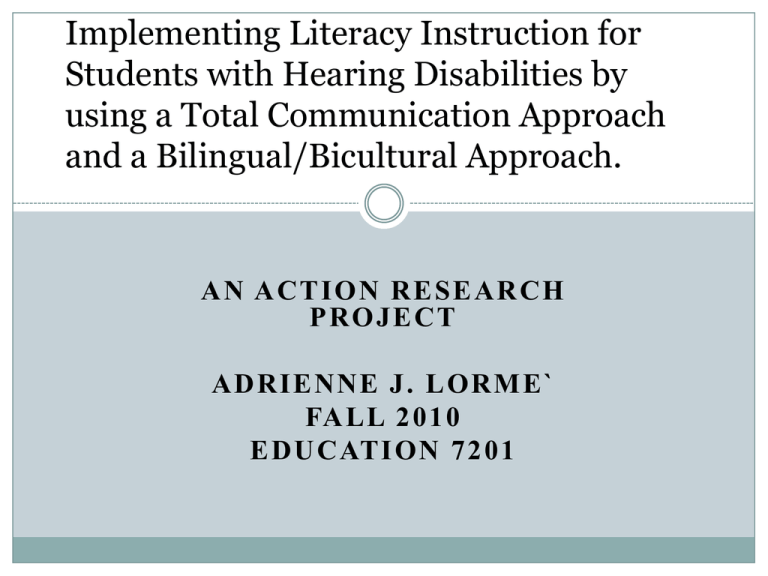
Implementing Literacy Instruction for Students with Hearing Disabilities by using a Total Communication Approach and a Bilingual/Bicultural Approach. AN ACTION RESEARCH PROJECT ADRIENNE J. LORME` FALL 2010 EDUCATION 7201 Table of Contents • Abstract • Introduction -Statement of the Problem -Statement of the Hypothesis -Review of Related Literature 3 4 5-11 • Method- Coming soon to a PowerPoint near you -Participants -Instruments -Experimental Design -Procedure Table of Contents Results • Discussion • Implications • References • Appendices -Appendix A -Appendix B -Appendix C 12-15 Statement of the Problem Students with hearing disabilities struggle to read and write mainly because of their inability to phonetically break down a written word. This limits and delays their ability to develop acquisition of vocabulary and effectively reduces literacy opportunities normally available to their hearing counterparts. Therefore, hearing impaired students will benefit from a more structuralized phonetic instruction that allows them to use a variety of strategies that will help with vocabulary growth and comprehension. Hearing impaired students are taught how to read by a variety of approaches such as: Total Communication and Bilingual/Bicultural. Both approaches incorporates phonics by using ASL and spoken language but use different instructional strategies. Statement of the Hypothesis The same reading lessons will be taught to two classes at School X, in New York City. Students who are taught using a TC approach will perform better than students using a Bi/Bi Approach. Students using a TC approach will demonstrate higher vocabulary acquisition and comprehension than those using a Bi/Bi approach. What is the Total Communication Approach? • Allows students to blend speech, ASL, and lip reading together. • Students can switch back and forth between these methods in order to use the best approach to help them comprehend the text . • ( WA LW O R T H , M O O R E S , & O ’ R O U R K E . , 1 9 9 2 ) . What is the Bi/Bi Approach? • C h i l d re n l e a r n t o s i g n f i r s t a n d t h e n later learn Spoken English. (Ramsey & Padden, 1998;) Review of the Literature The Importance of Phonic Instruction Children with hearing disabilities have weak phonological awareness of the alphabet and this weakness correlates to their inadequacy with reading. (Bergeron, Lederberg, Easterbrooks, Miller, & Connor, 2009). • Phonic instruction leads to language acquisition. (Ling, 1988). • Helps students develop an understanding of how words are used in sentences. (Shankweiler & Liberman, 1989). • Experiences in linguistics increases their knowledge of how words should be read in a sentence. (Marschark, Sapere, & Convertino, 2009). Helps students develop a face-to-face form of their spoken language (Mayer, 2007). TC and Bi/Bi approach incorporating Phonics Researchers and Theorists who are against both approaches Students fall behind in reading because they are not given adequate reading time to comprehend the material. (Donne & Zigmond, 2008). Hearing impaired students lag in reading because they often lack metacognitive skills and syntactic knowledge. (Miller, 2005). Reading development is contingent on a fully developed primary language. Therefore, incomplete or inconsistent signed or spoken language may affect the development of reading proficiency. (Chamberlain , 2002). TC Approach PRO’STheorists/Prationers who support a TC Approach Increases interaction with spoken language and therefore allows students to better comprehend how a word is used in a sentence. (Mayer, 2007; Council for Exceptional Children, 2010; ) Students who used an oral approach were able to comprehend the text better than students who were signed the text. (Marschark et.al, 2009). CON’s-Theorists and who are against a TC Approach Signers/speakers alter their messages to accommodate signing or speaking and therefore messages and comprehension become tangible. (Cerney, 2007). BI/BI Approach Pro’s- Theorist and Practioners who support Bi/Bi Con’s-Theorists and Practioners who are against Bi/BI Helps students find and embrace ASL and English do not share a their identity within the Deaf Culture (Chaleff and Ritter, 2001; Evans, 2004). phonological system that is remotely similar on many levels. (Haptonstall-Nykaza & Schick, 2007). Students will never learn to efficiently use their residual hearing, develop speech or correct phonemes-graphemes of words. (Lynas, 2005). Gives children the maximum amount of comprehensible input and foster cognitive development that is needed for literacy. (Eisenbraun, Johnstone, Lazarus, Liu, Matchett, Moen, & Quenemoen, 2009). Strategies used for Reading Instruction TC Approach Bi/Bi Approach Fingerspelling Fingerspelling Lip Reading/Speech ASL Reading (Harris and Moreno, 2006). ASL Visual-Auditory Learning Cued Speech Spoken English References Bergeron, J.P., Lederberg, A.R., Easterbrooks, S.R., Miller, E.M., & Connor, C.M. (2009). Building the Alphabetic Principle in young children who are deaf or hard of hearing. The Volta Review, 109(2-3), 87-119. Cerney, J. (2007). Deaf education in America: Voices of children from inclusion settings. Washington, DC: Gallaudet University Press. Chaleff, C & Ritter, M. (2001). The use of miscue analysis with deaf readers. The Reading Teacher, 55(2), 190-200. Chamberlain, C. (2006). Reading skills of deaf adults who sign: Good and poor readers compared. Unpublished doctoral dissertation, McGill University, Montreal. Donne, V., & Zigmond, N. (2008). Engagement during reading instruction for students who are deaf or hard of hearing in public schools. American Annals of the Deaf, 153(3), 294-303. Evans, C. (2004). Literacy development in deaf students: Case studies in bilingual teaching and learning. American Annals of the Deaf, 149(1), 17-30. Harris, M & Moreno, C. (2006). Speech reading and learning to read: A comparison of 8-year-old profoundly deaf children with good and poor reading ability. Haptonstall-Nykaza, T & Schick, B. (2007). The transition from fingerspelling to English print: Facilitating English decoding. Journal of Deaf Studies and Deaf Education, 12(2), 172-183. References Ling, D. (1988). Foundations of spoken language for hearing-impaired children. Washington, DC: Alexander Graham Bell Association of the Deaf. Lynas, W. (2005). Controversies in the education of deaf children. Current Paediatrics, 15, 200-2006. Marschark, M., Sapere, P., & Convertino, C. (2009). Are deaf students’ reading challenges really about reading? American Annals of the Deaf, 154(4), 357-370. Mayer, C. (2007). What really matters in the early literacy development of deaf children. Journal of Deaf Studies and Deaf Education, 12(4), 411-431. Miller, P. (2005). Reading comprehension and its relation to the quality of functional hearing: Evidence from readers with different functional hearing abilities. American Annals of the Deaf, 150(3), 305-323. Ramsey, C., & Padden, C. (1998). Natives and newcomers: Gaining access to literacy in a classroom for deaf children. Anthropology and Education Quarterly, 29(1), 5-24. Shankweiler, D., & Liberman, (Eds.). (1989). Phonology and reading disability: Solving the reading puzzle. Unknown, MI: The University of Michigan Press. Walworth, M., Moores, D., & O’Rourke, T. (1992). A free hand: Enfranchising the education of deaf children. Springfield Springs, MD: T.J. Publishers.

